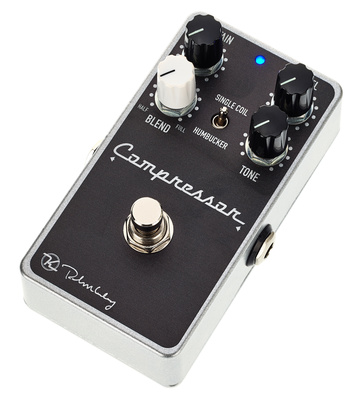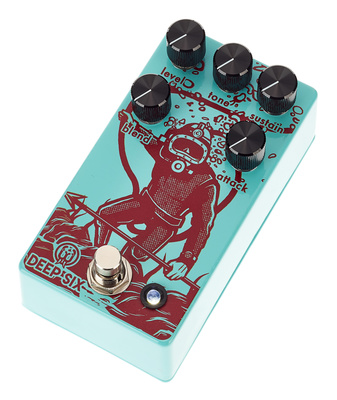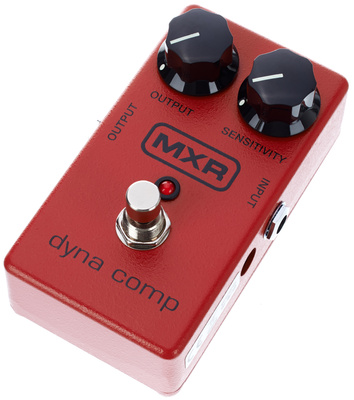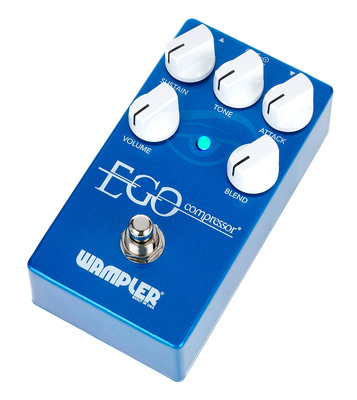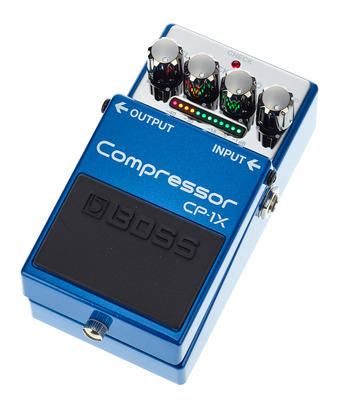The five best compressor pedals
Most guitar beginners are probably familiar with delay and distortion. But what exactly are compressor pedals, which can be found on the pedalboards of so many guitarists? This article will show you and reveal our five current favorites.
What are compressor pedals actually good for?
As the name suggests, a compressor pedal compresses your sound. You may be wondering what that's good for. After all, compression is otherwise known as a necessary evil for keeping audio files small.
However, a compressor pedal does not degrade your sound. Rather, it allows you to limit the volume level of your guitar signal. The difference between the loudest and quietest sounds is called the dynamic range, and a compressor's job is to reduce this range. A compressor pedal attenuates loud sounds to accomplish this.
The main advantage of compressors is that they enable you to stand out in quieter sections of a band's mix without having to increase your volume and risk overdriving everything when you transition to the next loud section. A compressor can make your life as a guitarist a lot easier, especially for non-distorted parts.
Even in distorted tracks, using a compressor can improve your sound. First, most compressor pedals allow you to adjust the attack level, which affects how bright or muffled your sound is when it first starts. Second, a compressor can provide sustain by raising quiet sounds and lowering loud ones, making notes linger a bit longer.
In the signal chain, compressors are usually placed at the very beginning, right after the guitar (or a tuner, if you use one). This way, the compressor only affects your guitar's output signal and does not compress your other effect pedals, which would probably sound awful.
What types of compressor pedals are there?
Compressor pedals for guitars are primarily digital or analog. Analog compressors have a fixed circuit through which the sound is sent. Digital pedals, on the other hand, achieve their effect using algorithms that run on the hardware.
Otherwise, individual pedals differ in the number and type of settings they offer. Many pedals have the following controls, for example:
Attack: This determines how quickly the compressor engages when you strike the strings. It also affects how bright or dark the sound is perceived to be. For example, with a long attack time, you hear more of the percussive effect of your pick. With a short attack time, however, you hear less, and everything sounds a little more muted.
Threshold/Level: This determines the volume at which the compressor reacts. If the input signal is louder than the threshold, the volume is reduced.
Ratio/Level: Ratio determines the ratio at which the volume is reduced. For example, with a ratio of 3:1, if the input volume is three decibels above the threshold, the output volume will only increase by one decibel. Therefore, this setting directly limits the dynamic range.
Blend/Mix: Some pedals allow you to mix in the unprocessed signal. The ratio at which this happens is determined by this control. Such a mix can make the compressed sound a little more natural.
Sustain: Many compressor pedals also function as sustain pedals. In most cases, they have a corresponding control that determines how long a note reverberates.
Tone/Mid/Low/High: Some pedals have equalizer functions that allow you to adjust the brightness of the sound using a tone control or separate controls for low, mid, and high frequencies.
Compressor Pedals for Guitarists: Our five favorites:
We currently like the following compressor pedals and would recommend them. As with our other articles on effects pedals, the pedals listed here are not necessarily the best-sounding overall. Rather, they are recommended devices from different price ranges. Sometimes they stand out because they offer interesting additional features.
Keeley Compressor Plus
At around $150, we believe the Compressor Plus is the best affordable all-around compressor. The device has true bypass and four knobs for sustain, level, blend, and tone.
Keeley takes a different approach to setting the attack level on its pedal. Rather than a rotary control, there is a toggle switch on top with two settings: "Single Coil" and "Humbucker", which guitarists will understand without much explanation. Otherwise, the compact pedal has a footswitch to activate bypass mode.
We like that the Compressor Plus has excellent sound quality for its price, produces little to no noise, and is easy to use. The pedal can be powered by a 9V battery or a separately available power supply.
Walrus audio Deepsix V3
The Deepsix from Walrus Audio is not only aesthetically pleasing with its illustration of a diver on the light green housing, but it also impresses with its inner values. With a price tag of just over 200 euros, it's clearly aimed at advanced users and professionals.
It combines the professional sound of a Universal Audio 1176 studio compressor with simple operation. The pedal has four knobs for level, sustain, blend, and attack. With an internal voltage of 18 volts, the Deepsix V3 provides ample flexibility to customize the sound to your liking.
The Walrus Audio device also features true bypass, of course. It is turned on and off via the integrated footswitch, which indicates the status with a corresponding LED. The pedal is powered by a 9-volt power supply, which is not included.
In our opinion, the Deepsix V3 is one of the best compressor pedals available to the average person.
MXR Dynacomp
The MXR Dynacomp is the ultimate classic among compressor pedals, and it's our favorite in the under-$100 range. The Dynacomp was one of the first compressor pedals and was used by music greats such as the Beatles. These small, red pedals are particularly popular in country and funk genres.
There is hardly another pedal that is easier to use than the Dynacomp. It offers only two controls: output (volume) and sensitivity (compression). If you're looking for an easy-to-use pedal and don't need flexible settings, the MXR Dynacomp is a good choice.
Wampler Ego Compressor
Priced at around $230, the Ego Compressor from Wampler is aimed at advanced users and professionals. The stylish blue metal pedal has five white knobs for sustain, tone, attack, volume, and blend. A blue LED forms the iris in the eye illustration on top of the Ego Compressor. It indicates whether the pedal is active or in true bypass mode.
The device is powered by a 9V battery or power supply, both of which must be purchased separately. In our opinion, the Ego is currently one of the best compressors on the market, offering an ideal combination of value, functionality, and versatility.
The Wampler device is so versatile that it is suitable for anyone who wants a compressor they can set up once and use for anything.
Boss CP-1X
No, the CP-1X is not the name of a Star Wars android; it is what we consider to be the best Boss compressor pedal. The device has the standard Boss design and is blue. However, a nice visual departure from the usual Boss formula is the chrome-look control panel with a row of colored LEDs and four silver knobs.
At around €170, the CP-1X is a high-end, mid-range pedal. Thanks to its four knobs for level, attack, ratio, and compression, it is very versatile. Like the slightly more expensive Deepsix from Walrus Audio, it operates internally at 18 volts. The only drawback is the rather short battery life. It can be powered by an AC adapter, which must be purchased separately.
Another cool feature of the CP-1X is its row of colored LEDs. They range from red to green and indicate the amount of compression applied to your sound. We particularly like the Boss pedal's transparent sound, which is probably due to its signal processing technology, Boss Multi-Dimensional Processing (MDP). MDP actively analyzes and dynamically adjusts the input signal.
Conclusion
A compressor pedal is not a necessity for every guitarist. You can probably get by without one, especially when you're just starting out. However, there are good reasons to purchase one in the medium term. If you play a lot of undistorted music, you should definitely consider buying one. We hope our brief overview has provided some initial guidance!
